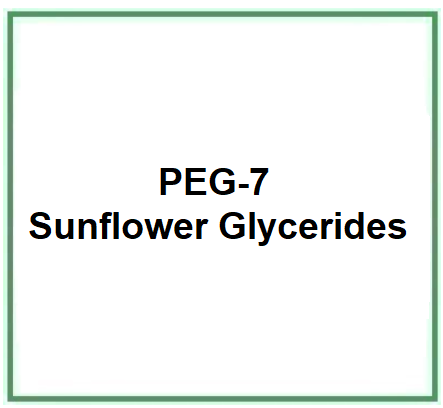PEG-7 Sunflower Glycerides is a chemical compound, alkyl glyceride, a mixture derived from PEG (PEG stands for Polyethylene glycol) from sunflower oil mono- and diglycerides. The number appearing after the abbreviation PEG refers to mol of ethylene oxide and the higher this number is, the less it can penetrate the skin.
The name describes the structure of the molecule:
- PEG stands for polyethylene glycol, a polymeric compound used in many cosmetic applications for its solubilizing and hydrating properties. The number "7" indicates the average molecular weight of the polyethylene glycol used, which affects the consistency and solubility of the product.
- Sunflower Glycerides refers to glycerides derived from sunflower oil. Glycerides are compounds formed from glycerol and fatty acids. In this context, they indicate that the product contains emollient and moisturizing components derived from sunflower oil.
Raw Materials Used in Production.
PEG-7 Sunflower Glycerides are derived from the reaction of sunflower oil glycerides with ethylene oxide. Sunflower oil is extracted from sunflower seeds, and ethylene oxide is an industrial chemical compound.
Step-by-step Summary of Industrial Production Process.
- Extraction of sunflower oil from sunflower seeds.
- Conversion of the oil to glycerides (triglycerides).
- Reaction of the glycerides with ethylene oxide to form the ethoxylated compound (PEG-7 Sunflower Glycerides).
- Purification of the product to remove impurities and reaction residues.
- Quality control to ensure compliance with standards.
Form and Color.
PEG-7 Sunflower Glycerides typically appear as a viscous liquid, usually colorless or pale yellow.

What it is used for and where
Cosmetics
Skin conditioning agent - Emollient. Emollients have the characteristic of enhancing the skin barrier through a source of exogenous lipids that adhere to the skin, improving barrier properties by filling gaps in intercorneocyte clusters to improve hydration while protecting against inflammation. In practice, they have the ability to create a barrier that prevents transepidermal water loss. Emollients are described as degreasing or refreshing additives that improve the lipid content of the upper layers of the skin by preventing degreasing and drying of the skin. The problem with emollients is that many have a strong lipophilic character and are identified as occlusive ingredients; they are oily and fatty materials that remain on the skin surface and reduce transepidermal water loss. In cosmetics, emollients and moisturisers are often considered synonymous with humectants and occlusives.
Surfactant - Emulsifying agent. Emulsions are thermodynamically unstable. Emulsifiers have the property to reduce the oil/water or water/oil interfacial tension, improve emulsion stability and also directly influence the stability, sensory properties and surface tension of sunscreens by modulating their filmometric performance.
Since the PEG (Polyethylene glycol) family is very numerous and can be found in cosmetic, industrial, pharmaceutical, medical and other products, it is necessary to make an introductory statement on the subject, which is rather complex from a safety point of view because these products not only come into contact with the skin, but, as in the case of medical products, are ingested.
PEGs (polyethylene glycol) polymerise condensed ethylene oxide and water and are referred to as polyethylene glycols, but in reality they are complex chemical components, polymers bonded together. For example, plastic is polyethylene and has a hard consistency, while polyethylene combined with glycol forms a liquid. PEGylation is produced not only as etherification, but also as transesterification, which is the transformation of an alcohol by an ester. The number appearing after the abbreviation PEG refers to mol of ethylene oxide and the higher this number is, the less it can penetrate the skin.
Safety.
The term 'eth' refers to the ethoxylation process (reaction with ethylene oxide) after which residues of ethylene oxide and 1,4-dioxane, chemical compounds considered carcinogenic, may remain in the final product. It depends on the degree of purity resulting from the completed reaction.
CAS: 186511-05-7 180254-52-8 generics
![]() PEG-7 Sunflower Glycerides
PEG-7 Sunflower Glycerides 


